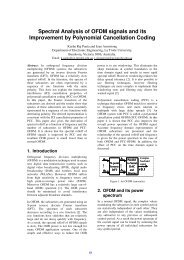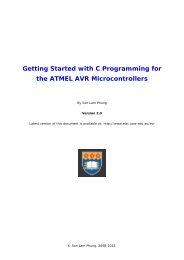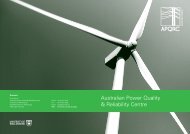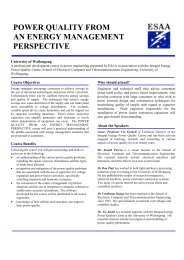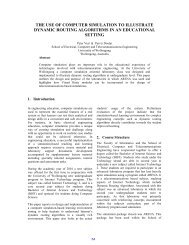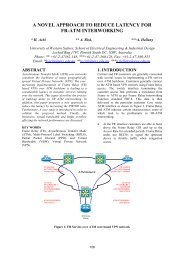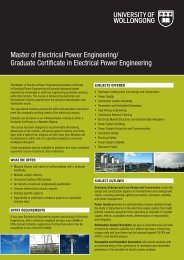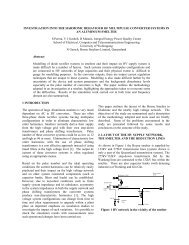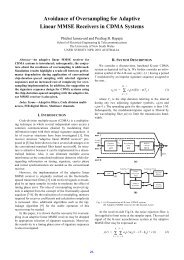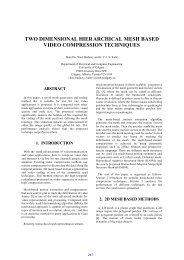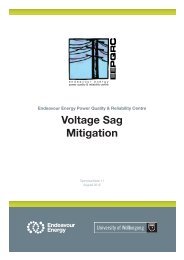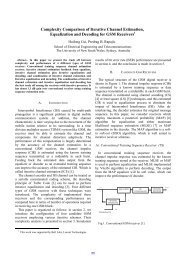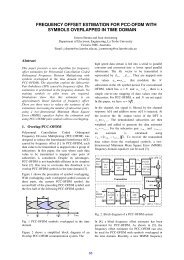Impact of Untransposed 66kV Sub-transmission Lines on Voltage ...
Impact of Untransposed 66kV Sub-transmission Lines on Voltage ...
Impact of Untransposed 66kV Sub-transmission Lines on Voltage ...
Create successful ePaper yourself
Turn your PDF publications into a flip-book with our unique Google optimized e-Paper software.
where,<br />
α - voltage index for active power<br />
β - voltage index for reactive power<br />
subscripts:<br />
0 - referred to rated c<strong>on</strong>diti<strong>on</strong>s<br />
The α and β parameters <str<strong>on</strong>g>of</str<strong>on</strong>g> this model can be set<br />
to represent the aggregate effect <str<strong>on</strong>g>of</str<strong>on</strong>g> different types <str<strong>on</strong>g>of</str<strong>on</strong>g><br />
composite loads (e.g. resistive loads, lighting).<br />
3.3. TRANSMISSION LINES<br />
Overhead <str<strong>on</strong>g>transmissi<strong>on</strong></str<strong>on</strong>g> lines are modelled as electromagnetically<br />
coupled impedance matrices in phase coordinates.<br />
Phase impedance matrix ([Z pq ] (3×3) ) for a<br />
three-phase <str<strong>on</strong>g>transmissi<strong>on</strong></str<strong>on</strong>g> system with earth return is<br />
derived starting from Cars<strong>on</strong>’s formula [9].<br />
( )<br />
De<br />
Z pq = R d +R s +k ln<br />
D pq<br />
( )<br />
De<br />
Z pq = R d + k ln<br />
D pq<br />
Ω/m, when p = q (4)<br />
Ω/m, when p ≠ q (5)<br />
where,<br />
R d = 9.869 × 10 −7 √f<br />
Ω/m, earth resistance<br />
D e = 658.376 ×<br />
ro<br />
f<br />
m<br />
k = 2 × { 10 −7 H/m<br />
c<strong>on</strong>ductor GMR (m), when p = q<br />
D pq −<br />
GMD between p and q (m), when p ≠ q<br />
R s - ac resistance <str<strong>on</strong>g>of</str<strong>on</strong>g> the c<strong>on</strong>ductor (Ω/m)<br />
f - operating frequency (Hz)<br />
r o - earth resistivity (Ωm)<br />
subscripts:<br />
p and q = a, b, c<br />
Since individual lines <str<strong>on</strong>g>of</str<strong>on</strong>g> the study system c<strong>on</strong>sist <str<strong>on</strong>g>of</str<strong>on</strong>g><br />
number <str<strong>on</strong>g>of</str<strong>on</strong>g> secti<strong>on</strong>s with different tower c<strong>on</strong>figurati<strong>on</strong>s<br />
and c<strong>on</strong>ductor material, the phase impedance matrix is<br />
obtained for each secti<strong>on</strong> and the resultant impedance<br />
matrix for the entire line is derived by combining the<br />
secti<strong>on</strong>al impedance matrices.<br />
3.4. CAPACITOR BANKS<br />
Three-phase capacitor banks are c<strong>on</strong>sidered as passive<br />
elements and are modelled as a diag<strong>on</strong>al impedance<br />
matrix. This allows reactive power injecti<strong>on</strong> by capacitor<br />
banks to be determined by the nodal voltage.<br />
4. FORMULATION OF THREE-PHASE<br />
POWER FLOW EQUATIONS<br />
4.1. CONCEPT OF COMPONENT LEVEL POWER<br />
FLOW CONSTRAINTS<br />
A unique problem in three-phase power flow analysis<br />
is the need to model numerous comp<strong>on</strong>ent c<strong>on</strong>necti<strong>on</strong>s,<br />
such as the phase to phase or delta c<strong>on</strong>necti<strong>on</strong>s <str<strong>on</strong>g>of</str<strong>on</strong>g> loads,<br />
and impedance grounded star or delta c<strong>on</strong>necti<strong>on</strong>s <str<strong>on</strong>g>of</str<strong>on</strong>g><br />
generators. The c<strong>on</strong>cepts <str<strong>on</strong>g>of</str<strong>on</strong>g> specifying power flow c<strong>on</strong>straints<br />
for each bus or each phase <str<strong>on</strong>g>of</str<strong>on</strong>g> a bus cannot take<br />
comp<strong>on</strong>ent c<strong>on</strong>necti<strong>on</strong>s into account. It is therefore not<br />
suitable for generalised power flow analysis. In view <str<strong>on</strong>g>of</str<strong>on</strong>g><br />
the fact that the power c<strong>on</strong>straints such as specified generati<strong>on</strong><br />
(or c<strong>on</strong>sumpti<strong>on</strong>) <str<strong>on</strong>g>of</str<strong>on</strong>g> real power are the properties<br />
<str<strong>on</strong>g>of</str<strong>on</strong>g> comp<strong>on</strong>ents instead <str<strong>on</strong>g>of</str<strong>on</strong>g> buses [7]. Therefore the load<br />
flow c<strong>on</strong>straints for each power system comp<strong>on</strong>ent are<br />
expressed in comp<strong>on</strong>ent level here, instead <str<strong>on</strong>g>of</str<strong>on</strong>g> c<strong>on</strong>straints<br />
<strong>on</strong> nodal quantities which have been used in traditi<strong>on</strong>al<br />
power flow methods.<br />
Since each comp<strong>on</strong>ent can be c<strong>on</strong>nected in any form<br />
using node renaming, arbitrary comp<strong>on</strong>ent c<strong>on</strong>necti<strong>on</strong>s<br />
with power flow c<strong>on</strong>straints can be easily represented.<br />
Furthermore, the approach allows the c<strong>on</strong>necti<strong>on</strong> <str<strong>on</strong>g>of</str<strong>on</strong>g><br />
different load types into the same network bus, thus<br />
providing the capability to model a wide variety <str<strong>on</strong>g>of</str<strong>on</strong>g><br />
unbalanced bus loading c<strong>on</strong>diti<strong>on</strong>s.<br />
4.2. COMPONENT CONSTRAINTS<br />
Comp<strong>on</strong>ents with power flow c<strong>on</strong>straints such as loads<br />
and generators are represented by their respective comp<strong>on</strong>ent<br />
models and the associated power flow c<strong>on</strong>straints,<br />
as follows:<br />
(a) Slack generator: The specified c<strong>on</strong>straints are the<br />
magnitude and the phase angle <str<strong>on</strong>g>of</str<strong>on</strong>g> the positive sequence<br />
voltage(V specified ) at the machine terminals.<br />
where,<br />
[T ] = 1 3 [1 a a2 ]<br />
[T ]([V k ] − [V m ]) = V specified (6)<br />
(b) PV generator: The specified c<strong>on</strong>straints are the threephase<br />
active power output (P 3φ, specified ) and the magnitude<br />
<str<strong>on</strong>g>of</str<strong>on</strong>g> the positive sequence voltage (V specified ) at the<br />
machine terminals.<br />
Real ( − [I km ] H ([V k ] − [V m ]) ) = P 3φ, specified (7)<br />
| [T ]([V k ] − [V m ]) |= V specified (8)<br />
where,<br />
superscripts:<br />
H - denotes c<strong>on</strong>jugate transposed<br />
The machine internal voltage (E) in (1) is unknown and<br />
must be adjusted to satisfy the above machine power flow<br />
c<strong>on</strong>straints.<br />
(c) Loads: The specified c<strong>on</strong>straints are the single phase<br />
active and reactive power ((P + jQ) 1φ, specified ) c<strong>on</strong>sumpti<strong>on</strong>.<br />
I H km(V k − V m ) = (P + jQ) 1φ, specified (9)<br />
The network (<str<strong>on</strong>g>transmissi<strong>on</strong></str<strong>on</strong>g> lines and capacitor banks)<br />
which does not have power flow c<strong>on</strong>straints is repre-




